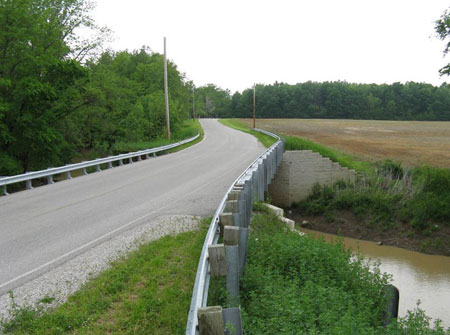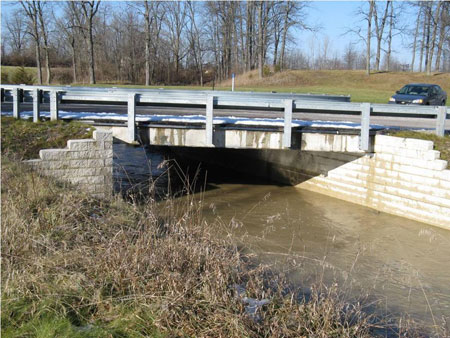U.S. Department of Transportation
Federal Highway Administration
1200 New Jersey Avenue, SE
Washington, DC 20590
202-366-4000
Focus
| Accelerating Infrastructure Innovations |
Publication Number: FHWA-HRT-13-010
Date: January/February
Printable Version (.pdf, 0.3 mb)
Using the Geosynthetic Reinforced Soil Integrated Bridge System (GRS-IBS), State and local transportation agencies across the country are redesigning their standard bridge. Now it's easy to start implementing the technology on your bridges with the Federal Highway Administration's (FHWA) Sample Guide Specifications for Construction of Geosynthetic Reinforced Soil-Integrated Bridge System (GRS-IBS) (Pub. No. FHWA-HRT-12-051).
Agencies can use the sample specifications as a basic template for developing their own standard specifications for GRS-IBS, incorporating local experiences and practices where applicable.
GRS-IBS can be used to build single span bridges on all types of roads. The technology offers the advantages of being faster, more economical, and easier to build than standard bridge construction methods. It is also extremely durable and can be built with readily available materials, using common construction equipment, and without the need for highly skilled labor. Defiance County, Ohio, built the world's first GRS-IBS bridge in 2005, followed by more than 20 additional bridges using the technology. New York's St. Lawrence County is now using GRS-IBS to replace many of its bridges, realizing cost savings of 50 to 60 percent.
FHWA selected GRS-IBS as one of the technology innovations for accelerated deployment by its Every Day Counts (EDC) initiative in 2010. The technology was included in the second round of EDC under the category of accelerated bridge construction. For more information about EDC, visit www.fhwa.dot.gov/everydaycounts.
GRS-IBS technology consists of three main components: the reinforced soil foundation (RSF), GRS abutment, and GRS integrated approach. The RSF is composed of granular fill material that is compacted and encapsulated with a geotextile fabric. The abutment uses alternating layers of compacted fill and closely spaced (less than 30 cm or 12 in) geosynthetic reinforcement to provide support for the bridge superstructure, which can be placed directly on the abutment without the need for a traditional bearing joint or cast-in-place concrete.
To construct the abutment, a row of facing blocks is followed by a layer of compacted granular fill, and then finished with a layer of geosynthetic reinforcement. This process is repeated until the required abutment height is reached. GRS is then also used to construct an integrated approach for the road that leads to the bridge, alleviating the common "bump" caused by differential settlement between the bridge and approach road.
FHWA's sample specifications cover both material requirements, including backfill material and geosynthetics, and construction requirements. Among the construction topics highlighted are labor and equipment; site layout; excavation; placement of backfill, compaction, geosynthetic reinforcement, and superstructure; integration of the approach road; and site drainage.
Also featured is contractor quality control (QC). Topics include creating a contractor QC plan, personnel and laboratory facility requirements, inspection, sampling and testing, and documentation and data evaluation. Agencies can also find sample specifications for project acceptance and contractor payment.
To download the Sample Guide Specifications, visit www.fhwa.dot.gov/publications/research/infrastructure/structures/12051/12051.pdf (.pdf). For more information, contact Jennifer Nicks at FHWA, 202-493-3075 (email: jennifer.nicks@dot.gov), or Daniel Alzamora at FHWA, 720-963-3214 (email: daniel.alzamora@dot.gov). Additional information on implementing GRS-IBS is available in FHWA's Geosynthetic Reinforced Soil Integrated Bridge System Interim Implementation Guide (Pub. No. FHWA-HRT-11-026), which is available at www.fhwa.dot.gov/publications/research/infrastructure/structures/11026/index.cfm. To view a construction video that demonstrates how to use GRS-IBS, visit FHWA's YouTube channel at www.youtube.com/user/USDOTFHWA (select "Turner-Fairbank Highway Research Center" and then choose "Geosynthetic Reinforced Soil-Integrated Bridge System"). The video can also be viewed on the FHWA EDC Web site at www.fhwa.dot.gov/everydaycounts/technology/grs_ibs/multimedia.cfm.

The Bowman Road Bridge in Defiance County, OH, was the first bridge in the world to use the Geosynthetic Reinforced Soil Integrated Bridge System (GRS-IBS).

Bridges built using the Geosynthetic Reinforced Soil Integrated Bridge System (GRS-IBS) include the Vine Street Bridge in Defiance County, OH.